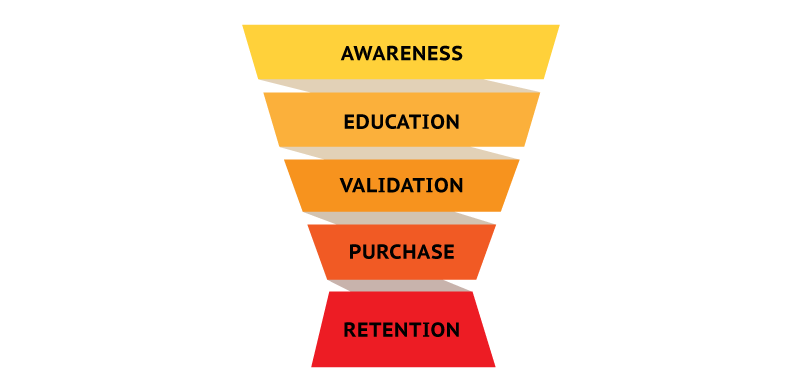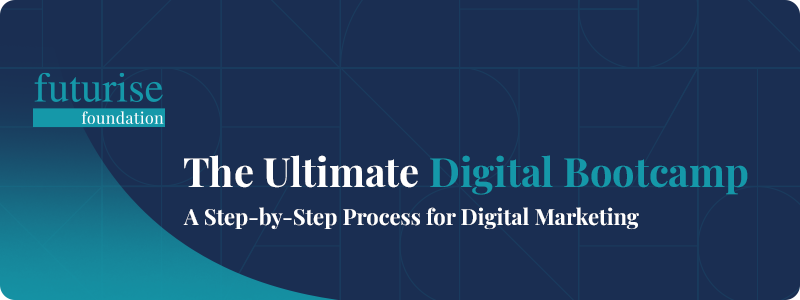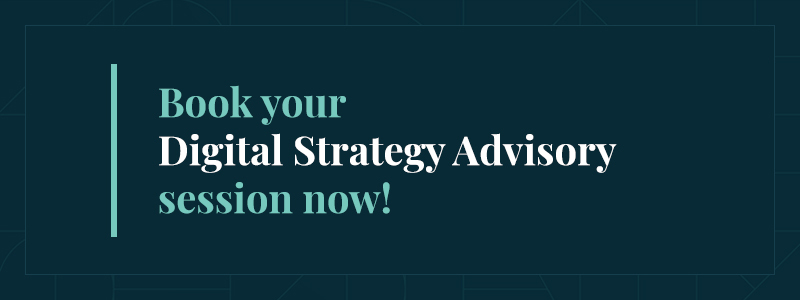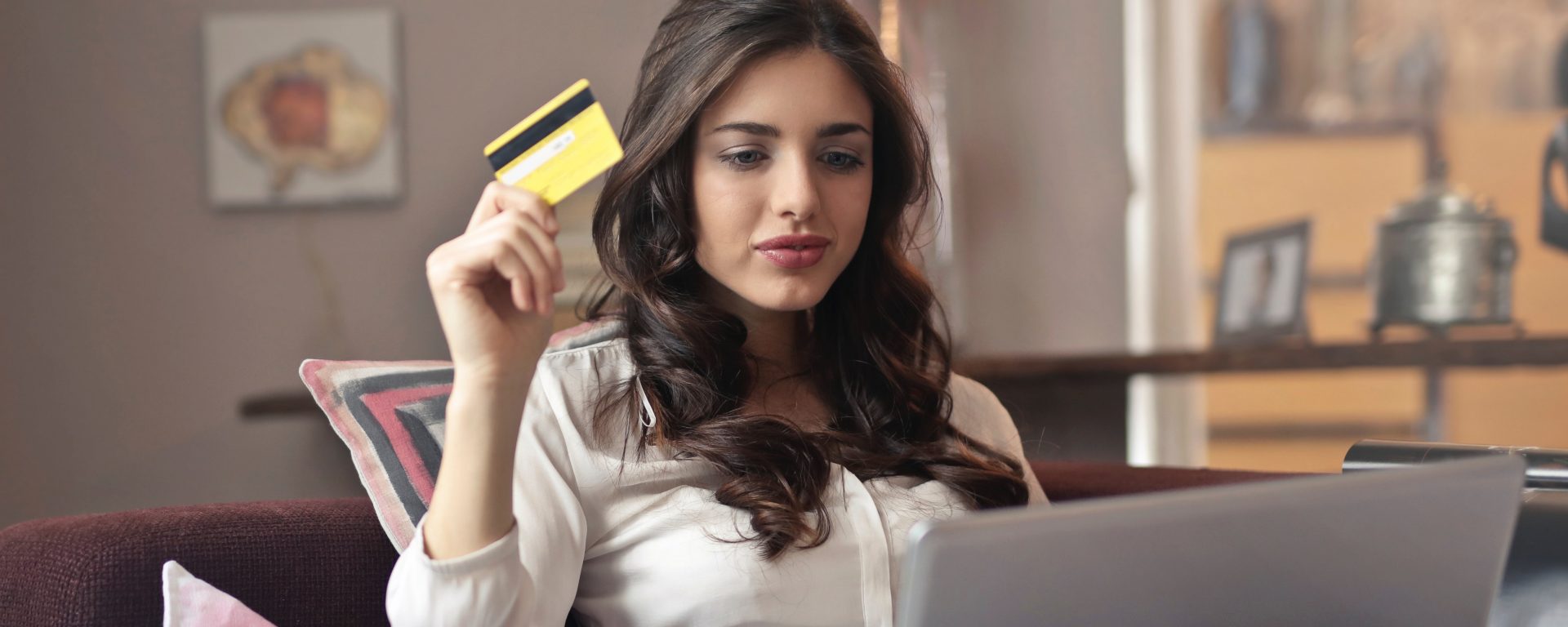In this article, I will introduce you to the customer’s buying journey; also known as the Hourglass Marketing Funnel, and the different marketing tools you can use at each stage of the customer journey to engage and maintain a loyal relationship with your customers.
We all want to understand our customer’s buying behaviour better so we can maximise their experience, value, and engagement with our brand. However, learning this psychology is like learning another language. Don’t worry, it’s in English so you’ll understand it easy!
What is the Hourglass Marketing Funnel?
No, it is not the funnel you use in the kitchen. The Hourglass Marketing Funnel is a graphical representation that outlines the progression of potential customers in their buying journey; from the very first contact the customer has with the brand (Awareness), to nurturing the customer’s interest (Education), confirming the customer’s need (Validation), all the way to the purchase of the product or service (Purchase) and then through to Customer (Retention).
For many businesses, the Purchase Stage of the funnel is the focal point. I mean everyone’s goal is to gain a sale and win new customers right?
However, if you are celebrating your sales like they’re big wins and neglecting your focus on customer retention in the post-purchase stage, then you are celebrating your victories way too early.
Compared to the traditional funnel model, the Hourglass Marketing Funnel includes Customer Retention after Purchase. This is a very important stage necessary for business’ attention.
The Customer Buying Journey: Why is it shaped as an Hourglass?

A lot of people perceive a customer’s buying journey to be a linear progression; from problem awareness to purchase.
The problem, however, is that not all customers are ready to buy. Yes, you may have a few odd ones who like to impulse buy but guaranteed, most consumers like to consider and evaluate before they purchase.
Some might not even purchase. This explains the hourglass shape of the Marketing Funnel.
Biking Example
Let me give you an example, and take you through the 5 stages of the Customer Buying Cycle. Assume you own a bike store.
At the beginning of the customer journey (also known as TOFU; top of the funnel), your biking business reaches out to 1000s of people on the world wide web through online advertising, who don’t know much about biking.
This is the Awareness stage, where your goal is to make yourself visible to your new customers and drive traffic to your website. The 1000s of consumers who find you on the internet represent the width at the top of the Hourglass Funnel.

The Next Step to Digital Empowerment of Small Business Owners
The Digital Bootcamp consist of 4-dynamic online modules designed to give you the right knowledge and tools of innovation to re-position your business and digitally transform for growth and success.
Moving down the funnel to the MOFU (middle of the funnel), those thousands of consumers are sieved through to the Education stage, where you inform them about the perks of riding bikes.
With this valuable, educational and intriguing content, a 100 of these consumers exchange their contact information for your weekly newsletter subscriptions on your website. This represents the conversion of traffic to lead, also known as the lead capturing of consumers in the Lead Generation Process.
Through these newsletter subscriptions, your bike business builds relationships with these leads over time with content marketing (lead nurturing and lead scoring). 10 of these consumers-turned leads evaluate whether your bikes satisfy their needs; does biking really help with my fitness?
Would I be able to take my bike everywhere? This represents the Validation stage of the customer buying journey, where your customers seek expert and peer validation for your product.
About 5 leads will be converted into your customers (because not everyone is ready to buy your bikes). This is the Purchase stage where consumers make a vendor and product comparison. They need to justify the quality and value of your bike in comparison to your competitors before they purchase.
Now at the end of the funnel, they buy and you’ve made a sale. You can give yourself a big high 5 and call it a day. NOT YET! It doesn’t stop here. One more step!

The Digital Strategy Advisory Sessions provide you with the best in digital expertise from experts in the field.
After these consumers purchase and have used your bike, you must not drop the ball and get complacent. To lock in this sale and all the referrals and repeat business that flow from it, make sure you show that you care – by thanking them and reminding them why they’ve made the right choice of buying your bikes.
Maintain this relationship, sustain frequent communication with them and encourage repeat purchases.
Not only will they become loyal to your business and repeat their bike purchase from you, but they will also advocate how durable and affordable your bikes are as a result of their customer satisfaction and brand trust. This is Customer Retention, also known as BOFU (bottom of the Funnel).
More and more people will hear about your bike business through Word of Mouth and over time, hundreds of people will be persuaded by these referrals, taking these new consumers back to the top of the funnel.
As you can see through this example, from 1000 to 100 to 10 to 5 to 100s, the gradual decrease of customers in the pre-purchase process is represented through the top half of the hourglass funnel, and the increase in customers in the post-purchase process is illustrated in the bottom half of the model.
With multiple channels and touchpoints, it is hard to identify when and where customers are won or lost. This explains why the customer buying process is an hourglass shape, and no longer a linear journey.
Conclusion
In today’s digital evolution, the customer’s buying journey has changed and no longer are customers purchasing in linear steps. Through the Hourglass Marketing Funnel, businesses need to acknowledge additional Retention strategies that are required to help maintain loyal and satisfied customers as well as advocacy of the business.
In my next blog, I will be providing suitable use of inbound and outbound marketing tools you can implement in your content strategy, to effectively engage with customers at each of the 5 stages of the customer journey; Awareness, Education, Validation, Purchase and Retention.
If you would like to have your marketing strategy aligned with your business’ objectives and goals, talk to one of our Digital Strategists at Netstripes here.
Hope you found this guide helpful. Join our Netstripes community on Facebook, Instagram and LinkedIn and stay up to date with the newest marketing trends, tips and events.
Are you ready to elevate your business to another level?
If you would like to have your digital marketing strategy aligned with your business’ objectives and goals, book a consultation with one of our Digital Strategists at Netstripes here.
Our digital specialists with years of marketing experience will be able to advise and propose digital marketing packages with supportive inbound strategies (including website development) and social media packages for affordable outbound strategies. Find out which marketing strategy is suitable for your business!
Feel free to talk to one of our digital strategists today. We are more than happy to help! Contact us now.



